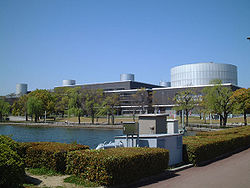
National Museum of Ethnology, Japan
Encyclopedia

Japan
Japan is an island nation in East Asia. Located in the Pacific Ocean, it lies to the east of the Sea of Japan, China, North Korea, South Korea and Russia, stretching from the Sea of Okhotsk in the north to the East China Sea and Taiwan in the south...
, is the Japan's largest research institute in the academic disciplines of humanities and social sciences, which was established in 1974 and opened to the public in 1977. It is built on the former grounds of Expo '70
Expo '70
was a World's Fair held in Suita, Osaka, Japan between March 15 and September 13, 1970. The theme of the Expo was "Progress and Harmony for Mankind." In Japanese Expo '70 is often referred to as Ōsaka Banpaku...
in Suita, Osaka
Suita, Osaka
is a city located in northern Osaka, Japan. As of August 1, 2011, the city has an estimated population of 356,751 and the density of 9,880 persons per km². The total area is 36.11 km²....
. The founding collection is known as the Attic Collection, and is an early 20th century ethnological
Ethnology
Ethnology is the branch of anthropology that compares and analyzes the origins, distribution, technology, religion, language, and social structure of the ethnic, racial, and/or national divisions of humanity.-Scientific discipline:Compared to ethnography, the study of single groups through direct...
collection of mainly Japanese materials, including some early finds of Jōmon archaeological artifacts (in the Morse Collection). Further collections were brought together for the opening in 1977 and collecting activities have continued since.
The main focus of collection has been film, still images, sound recordings, and objects representing diverse aspects of everyday life, from farming to food, urban life, folk crafts, and religion. Permanent galleries for all large regions of the world display only part of the full collection.
Two special exhibitions of approximately three months duration are presented in Spring and Autumn each year, and there are numerous smaller temporary exhibitions on special themes.
The museum has a staff of approximately 70 researchers, and actively supports visits by scholars around Japan and abroad. The museum library is one of the largest academic, multiple-language reference libraries in Japan, with books and journal in Japanese, English, Chinese, Spanish, and other languages. The library is linked to a national network of public university libraries.
The Museum offers PhD courses in association with Japan's Inter-University of Advanced Graduate Studies (Sokkendai), an inter-institutional organization that provides administration for students placed in public research institutes and laboratories all over Japan.
The National Museum of Ethnology is also a founding member of the National Institutes for Humanities (NIHU), Japan.
Postal address: National Museum of Ethnology, Senri Expo Park, Suita City, Osaka 565-8511, Japan.
Website: http://www.minpaku.ac.jp/english/

